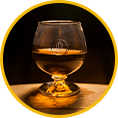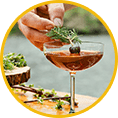When Jon Kreidler and Dan Oskey launched Tattersall Distilling in Minneapolis, their focus was craft cocktails. They’ve built their business on flavor-forward spirits and the cocktails people crave. Yet as the business grew they bumped into limits within Minnesota’s liquor laws.
Tattersall Distilling announced he launch of its first canned cocktail line. Made from its award-winning distilled spirits, the cocktails include Key Lime Gin + Tonic, Blueberry Basil Collins, Easy Street and Watermelon Bootlegger. Distributed in Minnesota and Wisconsin to start, Tattersall’s canned cocktails are now available at select liquor stores and Tattersall’s River Falls distillery in 4-packs of each can.
The microdistiller not only sources grains, fruit and materials from local suppliers — it repurposes as many byproducts of the distilling process as possible, in what’s likely one of the most scalable examples of circularity so far in the spirits business.
Tattersall River Falls is powered by a rooftop solar array that produces a yearly average of 472,000kWh of electricity. That’s like adding 5,517 trees to our forests.
As Minnesota-based Tattersall Distilling Co. continues to expand distribution across the United States, its rollout will be supported by its new distillery just over the border in Wisconsin.
Tattersall recently strengthened its Midwest footprint through partnerships with distributors in Illinois and Michigan. Restaurants, bars and liquor stores in those two states – and 23 others – will be stocked with Tattersall spirits produced in Wisconsin, not Minnesota.
The fast food chain is releasing an “extremely limited” line of fry-flavored vodkas, and it tapped two Minneapolis companies to help.
As the camaraderie and fuzzy intimacy of sitting at a dimly lit bar surrounded by strangers becomes an increasingly distant memory, more and more distilleries and restaurants are offering cocktail kits for at-home drinking pleasure. While we may not be congregating like we used to, we can channel that atmosphere and support our local haunts by making these cocktails at home — with their help, of course.
No matter what you’re putting in your drink, the simple act of making a beverage — made simpler with easy instructions and pre-measured ingredients — can be meditative. Take five minutes to make yourself something special.
In recent years, bottles of amaro have been hitting bar and retail shelves by the dozens. And while the Italian brands tend to be at the forefront of this movement, American amaro producers have been putting their mark on the category as well. And as amaro is a bitter liqueur originally created to aid in digestion, if you’re planning a huge feast–like say a Thanksgiving dinner–you may want to have an amaro or two on hand for folks who may overindulge.
Nothing can replace a favorite watering hole, but a healthy pour of something delicious at home is a respectable alternative—one most of us have taken liberal advantage of as our beloved bars and restaurants have been forced to close. Fortunately, there were many excellent options to choose from.
Smaller craft distilleries were hit much, much harder by the pandemic than the big brands, most of which didn’t suffer, at least financially. So while it can’t be denied that the large “comfort brands” continued to release some really good spirits in 2020, it’s remarkable that the craft world was able to put out some stellar bottles as well. Let’s recognize all of these spirits, because when you find something pleasurable in trying times, even if it’s small and perhaps inconsequential in the grand scheme of things, it’s worth celebrating.
When it comes to alcohol shrouded in mystery, it’s pretty tough to top absinthe. This wormwood and anise-flavored herbal spirit was illegal in the US from 1912 until 2007, when it was legalized with regulated levels of thujone — the naturally occurring, low-level stimulant that made the spirit so notorious in the first place.
For the record, absinthe has never has been poisonous in any way. The famous “green fairy” hallucinations are due to people being really, really drunk. Like “cut your ear off”-levels of drunkenness.
Regardless of the half-truths, stigmas, and overall air of secrecy surrounding absinthe, spring 2021 feels like a great time to give it a try. To pick a few favorite bottles, we asked a handful of bartenders to tell us the expressions they like to sip and mix with. Check their picks out below.
 Spirits & Liqueurs
Spirits & Liqueurs Gift Cards
Gift Cards Merchandise
Merchandise Cask Club
Cask Club Featured Recipes
Featured Recipes Craft Cocktail Bar & Eatery
Craft Cocktail Bar & Eatery Retail Market
Retail Market Event Calendar
Event Calendar Distillery Tours
Distillery Tours Classes
Classes Winter Market
Winter Market Private Events
Private Events Weddings
Weddings Catering
Catering Sourcing &
Sourcing & Meet the Team
Meet the Team Media
Media Distributors
Distributors